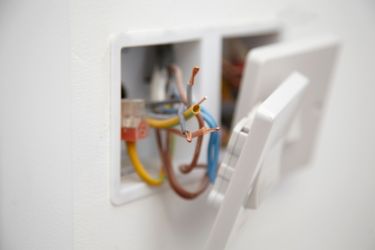
Written by Kayla Jane Barrie Updated on Dec 15, 2025 5 mins read

Electrical wiring is one of the many considerations when comparing houses, especially if you consider buying an older home in Ontario.
But what if you find knob and tube or 60-AMP? These old ways are electrical may not be safe and can cause issues for insurers. Electrical codes and standards have advanced a lot over the years. If your home isn’t structurally protected, insurers may have issues approving you.
Learn about the different types of electrical wiring in homes and how they may impact your home insurance costs.
Homes built before the 1980s create policy issues because of the electrical wiring. When you are house hunting, your home inspection will confirm the type of wiring. Unless your home or business is newly constructed, you may come across some of these wiring hazards :
You will only have coverage of replacing an electrical panel (breaker box) if it is damaged by a specific peril included in your policy.
If your electrical panel is damaged from fire or flood, it will be replaced. However, they will not include most old electrical panels or those that have been neglected in maintenance. If an old electrical panel malfunctions and causes damage, the replacement will not be covered, nor will any other damage be covered in the process.
If you notice that breakers keep blowing, you have an old fuse box, lights flicker, and dim, or the panel is outdated, it is likely time to upgrade. Shop around and get at least three estimates before you commit and ensure you have a certified electrician who specializes in panel and service upgrades. Depending on the upgrades, you can expect to spend between $500 and $2,000 to replace your electrical panel in Canada.
While knob and tube tend to get the most attention when discussing home wiring issues, aluminum wiring comes in a close second. The material is more affordable, malleable and used in various industries. Aluminum wiring became popular during the 1960s and 1970s due to the high price of copper – in fact, 55% of homes built during that time are more likely to have it.
However, many fires and deaths resulting from aluminum wiring caused builders to abandon it. It was not due to the actual wire, but rather it became a fire hazard if not installed correctly. The contact points can become corroded by oxygen or rust.
If you are looking for a new home, or want to see your current property for the type of wiring used, here’s how you can check :
Since aluminum wiring has been phased out due to safety concerns and is viewed as unsafe by insurers, you may have issues getting approved for protection. Like homes with knob and tube, some companies provide it, and others don’t.
Many insurers will require a complete inspection by a certified electrician before offering coverage. Depending on the wiring state, an upgrade to copper may be required to obtain approval. You may also be able to get it through specialty home insurance.
AMP electrical service is another electrical issue that could create problems. 60-AMP is found in homes built before 1950 - it is not designed to handle the electrical requirements of modern homes. Homes with 60-AMP service are at risk of overuse, overheating, and increased fire risk. This can happen if it draws more than 60-AMPs – it will cause the fuses to blow or the breaker to trip. Homes with 60-AMP service are at risk of overuse, overheating, and increased fire risk. This can happen if it draws more than 60-AMPs – it will cause the fuses to blow or the breaker to trip.
Today, the current standard for new homes is 100 AMPs, and some insurers may request you upgrade to 100-AMP service to get coverage. FSCO explains that you can upgrade or install a switching device that allows for the operation of one major appliance at a time.
Insurers will generally not cover the costs to upgrade the electrical. However, if there is a home insurance claim, you may be substituted for any damages depending on your policy.
Suppose you plan to purchase an older home with dated wiring - in that case, you may have issues getting coverage. You may be required to update your wiring or have an inspector approve it before you can get coverage. Only certified technicians can do electrical work in your home – you can visit the ESA to find a local technician.
They will not pay to replace outdated wiring or the cost to renovate your home’s electrical system. It will cover damage caused to your home if wiring arcs or causes a fire. It’s covered if the damage is caused by a peril included.
Since all companies are different, it’s good to clarify what is and is not protected with your plan.
If you need to begin renovations to upgrade writing, depending on how large your home is and how much needs to be replaced, costs can start around $2,000 and upwards to $20,000 for a larger house.
Copper wiring is more durable, and the connection points are less prone to breaking, fraying, corrosion, and oxidation. Aluminum is prone to breaking, fraying, corrosion, and oxidation. Although they can both be used in homes, make sure they are not installed together.
You can, but consider getting it checked out by a professional after installing a new electrical panel. DIY electrical work is inherently dangerous, and you may inadvertently violate local codes during the process, which can lead to serious issues.
Faulty wiring can be a threat to your home. If you ignore any warning signs or signals of potential issues, it's best to have it checked out. If you don’t act on this, your claim could be denied, and if you attempt to DIY the solution, it may also cause problems with your coverage.
Whether you are looking to purchase a new home or it’s time to renew your current policy, we will work to find you the protection you need. We'll go over any extra coverage you may need, such as homesharing insurance or contents insurance.
| Categories | Home |
|---|---|
| Tags | Home CoverageProtect Your HomeHome Maintenance |
Read our insurance blog to get helpful tips, information and news.
Has your car been totalled in an accident? Is your car a write off? Learn about vehicle write offs for a total loss insurance claim.
Get the facts on Toronto's auto theft problem. We break down the data, reveal the most-stolen vehicles (including the Honda CR-V and Lexus RX 350), and show which neighbourhoods are most affected.
Dive into the world of auto theft with our blog on the most stolen cars in Canada. See the most stolen cars across Canada, including provincial lists for Ontario and Quebec, and learn how high-risk models can affect your car insurance premiums.
Drive safe this winter! Check out these tips for driving in snowy and icy conditions in Ontario. Get other helpful info and FAQs on winter driving.